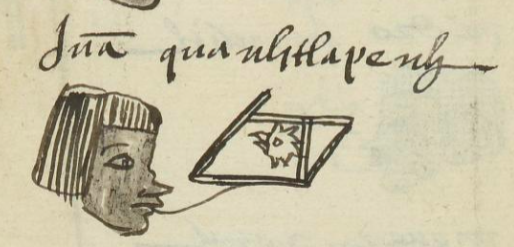Cuauhtlapeuh (MH555r)
This black-line drawing of the compound glyph for the personal name Cuauhtlapeuh (“Wooden Trap for Catching Animals") is attested here as a man’s name. It shows the head of an eagle (cuauhtli) in profile, looking toward the viewer's left. The eagle's eye and beak are open, and the feathers on its head are spiky. Surrounding the eagle's head is apparently a hunting trap (tlapehualli) made from wood (cuahuitl).
Stephanie Wood
The start of the name, Cuauh- (eagle) seems to serve as a phonetic indicator for the Cuauh- of "wood." The stems are homophones. The verb tlapehua refers to plowing, so a tlapehualli could be a plow, and cuauhtlapehualli could be a wooden plow. But this remains to be investigated.
Stephanie Wood
Juā quauhtlapeuh--
Juan Cuauhtlapeuh
Stephanie Wood
1560
arados, trampas, cazar, águilas, madera, tecnología, nombres de hombres, feathers, plumas

cuauhtlapehualli, a wooden trap for catching animals, https://nahuatl.wired-humanities.org/content/cuauhtlapehualli
cuauh(tli), eagle, https://nahuatl.wired-humanities.org/content/cuauhtli
cuahui(tl), tree, wood, https://nahuatl.wired-humanities.org/content/cuahuitl
tlapehua, to plow land, https://nahuatl.wired-humanities.org/content/tlapehua
tlapehual(li), a trap for hunting, https://nahuatl.wired-humanities.org/content/tlapehualli
posiblemente, Cepo de Madera Para Cazar
Stephanie Wood
Matrícula de Huexotzinco, folio 555r, World Digital Library, https://www.loc.gov/resource/gdcwdl.wdl_15282/?sp=189&st=image.
This manuscript is hosted by the Library of Congress and the World Digital Library; used here with the Creative Commons, “Attribution-NonCommercial-ShareAlike 3.0 License” (CC-BY-NC-SAq 3.0).





